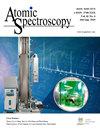Quantitative Analysis Of Bulk Composition Of Small-Size Lunar Samples Using Energy Dispersive X-Ray Spectroscopy
IF 2.3
2区 化学
Q1 SPECTROSCOPY
引用次数: 2
Abstract
: The major element composition analysis of lunar mare basalt bulk rock is crucial for understanding the thermochemical evolution of the lunar interior. However, lunar regolith and soils returned by the Apollo and Chang’E-5 missions have small particle sizes (mostly < 3 mm), making quantitative analyses of the bulk rock composition difficult. Herein, we developed a non-destructive technique to determine the bulk composition (comprising SiO 2 , TiO 2 , Al 2 O 3 , FeO, MnO, MgO, CaO, Na 2 O, and K 2 O) of rare lunar samples with a small size using scanning electron microscopy and energy dispersive X-ray spectroscopy (EDS) mapping techniques. In this study, a set of certified reference materials were used to calibrate the spectrometer; the precision and accuracy of the EDS analyses were verified using silicate glass and mineral reference materials. Measurements performed on a lunar meteorite sample with a known composition, NWA 4734, confirmed the reliability of the mapping method. The EDS data for the standard glasses and minerals were consistent with the reference values, within the error limits. A small fragment of NWA 4734 was measured using EDS mapping, and the bulk composition obtained was comparable to that measured using inductively coupled plasma mass spectrometry and inductively coupled plasma atomic emission spectrometry. Our method is standardized and minimizes the acquisition time compared to other quantitative mapping methods. The non-destructive and quantitative analysis method used in this study can support research on the bulk compositions of Chang’E-5 lunar samples and can be applied to research on both terrestrial and extraterrestrial samples at the micron- to centimeter-scale.利用能量分散X射线光谱法定量分析小型月球样品的体积成分
月球玄武岩块岩的主元素组成分析对于了解月球内部的热化学演化至关重要。然而,阿波罗和嫦娥五号任务返回的月球风化层和土壤颗粒尺寸较小(大多小于3毫米),因此难以对大块岩石成分进行定量分析。在此,我们开发了一种非破坏性技术,使用扫描电子显微镜和能量色散X射线光谱(EDS)绘图技术来确定小尺寸罕见月球样品的体成分(包括SiO2、TiO2、Al2O3、FeO、MnO、MgO、CaO、Na2O和K2O)。在本研究中,使用了一套经过认证的参考材料来校准光谱仪;使用硅酸盐玻璃和矿物参考材料验证了EDS分析的精度和准确性。对已知成分的月球陨石样本NWA 4734进行的测量证实了测绘方法的可靠性。标准玻璃和矿物的EDS数据与参考值一致,在误差范围内。使用EDS图谱测量NWA 4734的小片段,并且所获得的本体组成与使用电感耦合等离子体质谱法和电感耦合等离子体原子发射光谱法测量的本体组成相当。与其他定量绘图方法相比,我们的方法是标准化的,并最大限度地缩短了采集时间。本研究使用的无损定量分析方法可以支持嫦娥五号月球样品的整体成分研究,并可应用于微米至厘米尺度的陆地和地外样品研究。
本文章由计算机程序翻译,如有差异,请以英文原文为准。
求助全文
约1分钟内获得全文
求助全文
来源期刊

Atomic Spectroscopy
物理-光谱学
CiteScore
5.30
自引率
14.70%
发文量
42
审稿时长
4.5 months
期刊介绍:
The ATOMIC SPECTROSCOPY is a peer-reviewed international journal started in 1962 by Dr. Walter Slavin and now is published by Atomic Spectroscopy Press Limited (ASPL). It is intended for the rapid publication of both original articles and review articles in the fields of AAS, AFS, ICP-OES, ICP-MS, GD-MS, TIMS, SIMS, AMS, LIBS, XRF and related techniques. Manuscripts dealing with (i) instrumentation & fundamentals, (ii) methodology development & applications, and (iii) standard reference materials (SRMs) development can be submitted for publication.
 求助内容:
求助内容: 应助结果提醒方式:
应助结果提醒方式:


